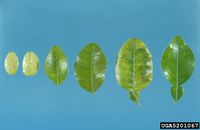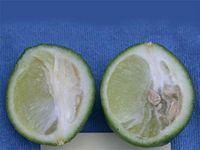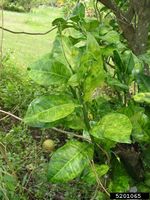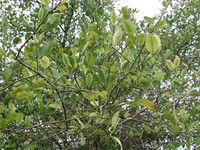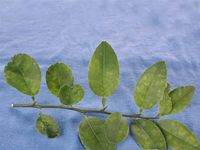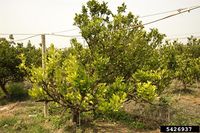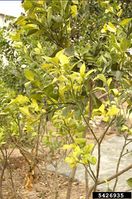Liberibacter asiaticus
| Literature database |
|---|
| 435 articles sorted by: |
| • year (descending) |
| • research topics |
| • countries/regions |
| • host plants |
| • list of antagonists |
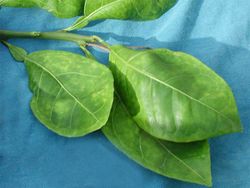
Author(s): Richard I. Davis, Secretariat of the Pacific Community
Source: PaDIL
Candidatus Liberibacter asiaticus Jagoueix et al. 1994 - (citrus huanglongbing)
The pathogens is a non-culturable bacterium which infects the phloem sieve elements of citrus trees, limiting their functions and causing the Asian form of citrus greening. The disease has been accidentally introduced from its native Asia into South America (first recorded in 2004) and North America (first detected in Florida in 2005). In Florida it spread rapidly, often reaching an incidence of 50% or more, accompanied by substantial yield reductions. The overall losses in Florida, in spite of control efforts, have been estimated at several billion U.S.$ per year (e.g. see Spreen et al. 2014). The disease is still spreading on the American continent.
ˋCa. L. asiaticusˊ has been also reported from eastern Africa. However a subsequent study suggested that these reports might have been based on the presence of ˋCa. L. africanus subsp. clausenaeˊ which can cause nontarget amplification of PCR products in tests for ˋCa. L. asiaticusˊ (Roberts et al., 2017).
Symptoms include yellow mottling, dieback, stunting and deformed fruits. Infected trees may remain symptomless for several years. It is transmitted by the psyllid Diaphorina citri or by grafting. The disease can also spread through infected planting material.
| Vernacular names | |
|---|---|
| • Deutsch: | Gelbe Drachenkrankheit |
| • English: | citrus huanglongbing |
| • Español: | enverdecimiento de los citricos enfermedad Huanglongbing forma asiática de Huanglongbing |
| • Français: | maladie du dragon jaune |
Control of the vector is the predominant management strategy. There are several species of Liberibacter causing similar citrus diseases (e.g. African huanglongbing) and correct identification usually involves PCR analysis.
The Gram-negative bacterium belongs to the Rhizobiaceae (α-proteobacteria) and is not flagellate. It lives and moves within the sieve tubes of the host plant. In the psyllid vector it also multiplies (circulative and persistent), moves into the salivary glands and subsequently back into the host plant. It can tolerate relative high temperatures (up to 35°C), in contrast to the other Liberibacter species.
For a review see Zheng et al. (2018).
Two other, less important bacteria cause also citrus huanglongbing diseases:
- Candidatus Liberibacter africanus (transmitted by a different psyllid species)
- Candidatus Liberibacter americanus (only known from some parts of Brazil).
Both are heat sensitive.
Synonyms:
Liberobacter asiaticum
- Other images of Liberibacter asiaticus (IPM Images and PaDIL - click to enlarge)
